Ensuring the safety of your business premises is essential for a professional company. It helps to protect your employees and any visitors. But it also protects you, both from criminal and civil action. If anything goes wrong, you could be in trouble and end up losing money and even your business.
So it’s vital that you pay attention to safety and health for your company and its survival. There are lots of things you should be doing to make sure that you’re doing as much as you can.
Checking the federal and local regulations is a good start, but you don’t have to do only the minimum. Follow these steps if you want to make your business premises a safer place.
Regular Risk Assessments
To minimize and prevent accidents, you need to know what risks you face. Every business will have different factors to take into account. However, there are many things that every company needs to think about. And there are certain risks that all offices, factories or construction sites will have to consider. It’s a good idea to perform a risk assessment to discover the problems that your workplace faces.
It involves inspecting the premises and noting potential hazards. You can then come up with solutions for avoiding accidents and injuries. You might also decide to hire a professional to conduct the assessment. Make sure to do them regularly too.
Adequate Training
It’s important for your staff to know how they can minimize the chance of accidents. When you work out how to avoid certain hazards, your employees should learn how. Staff training is usually an important factor in improving the safety of your business. It’s included in one of the six ways to improve safety outlined by http://www.entrepreneur.com/article/. This is particularly true in places where they might be operating machinery.
Your staff could be performing other hazardous activities too. They might need to know how to lift heavy objects or handle hazardous materials. They may even need to learn to sit in an office chair without damaging their back. Training should also be continuous, and not just a one-off event when staff are first hired.
Tracking and Investigating Incidents and Accidents
You can do as much as you can to prevent accidents, but that doesn’t mean they don’t happen. If they do, you should keep a record of anything that happens. You should know if someone gets hurt and try to form an idea of how it occurred.
Investigating any incidents shows that you take them seriously. In some cases, you might be required to support an accident to a regulatory body. This is usually when someone is seriously injured, or if a death occurs. If any accidents do result in legal action, it will be reassuring to have a record of the events.
Photo source: US Army Corps of Engineers
Uniform Regulations
There are many ways that you can make your workplace safer and more hygienic. One of the methods that many businesses use is the use of uniforms. Uniforms aren’t just for making your staff look like a unified workforce.
Although they’re useful for that, they can also improve safety and health in your business. For example, healthcare professionals should wear uniforms. Doing so helps to reduce the bacteria they bring into work.
However, this tactic is most effective if staff are required to change into their uniform at work. You can source hygienic clothes from many websites. Get your lab coats from http://www.uniformsandscrubs.com/meta-labwear.html, for example. You can also have uniforms designed to match your branding. They can be useful to reduce the likelihood of accidents such as clothing getting caught in machines too.
Signage and Handbooks
You should ensure that you put your safety and health legislation in writing. Putting up clear signs and posters around the workplace is one thing you need to do. There is an OSHA workplace safety poster that you should display somewhere prominent.
Your staff need to be able to see it so that they know their rights. You can also make your own posters in regards to particular issues around your premises. For example, they might remind people not to leave machinery unattended while it’s running. You can also create a health and safety handbook for your employees to read, and possibly sign.
Appointing Someone in Charge
You might not want to take on the responsibility of managing safety in your workplace. Instead, you can appoint someone else as the manager for all necessary tasks. They can ensure that people receive the right training and that incidents are recorded.
You should also make sure that someone is trained in first aid. So that there will always be a person capable of administering it. Even if you delegate overseeing safety to someone else, you should still check up on them. You need to make sure they’re carrying out their duty properly and have regular meetings.
Comply with Regulations
One of the most important things you need to do is comply with any federal or local safety regulations. You need to check which rules you are required to follow to keep your workers safe.
OSHA has many regulations you should check for both general industries and particular occupations. Go to www.osha.gov/law-regs.html to see a full list. You also need to see if there is anything you should know at a state or city level. If you don’t follow the rules, you could end up losing a lot of money due to a lawsuit or even facing criminal action.
Get Insurance
Accidents can still happen, even if you’re trying your best. And when you’re not at fault for an incident, it won’t necessarily stop someone suing you.
You should take out insurance for your business to protect it in the case of a lawsuit.
Insurance can help to cover any legal fees and compensation you might be asked to pay. Workers compensation insurance is essential for any business.
You should also have a lawyer who can help you in the event of anything happening. Having legal counsel available is another insurance in itself, and should protect you further.
Improving safety and health for your business can benefit you in many ways.
It will help you save money, and most importantly protect your employees.






